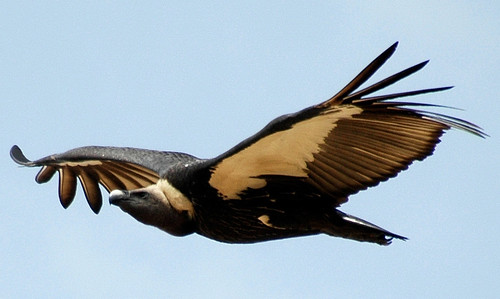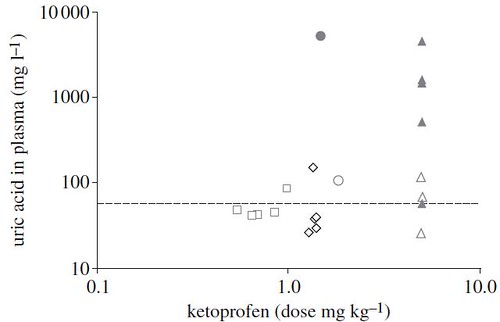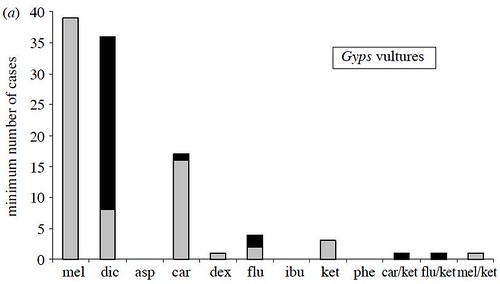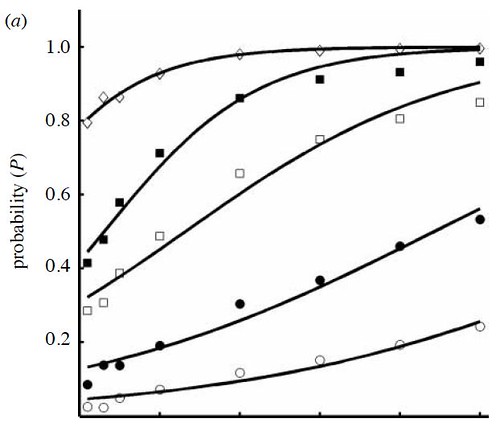tags: vultures, Gyps species, conservation biology, endangered species, veterinary medicine, toxicology, physiology, evolutionary biology, pharmaceutical chemistry, epidemiology, mathematical modeling, researchblogging.org,peer-reviewed research, journal club
Only thirty years ago, tens of millions of White-rumped Vultures, Gyps bengalensis,
were flying the skies of Asia. They are now classified as Critically Endangered.
Image: Marek Jobda / rarebirdsyearbook.com [larger view]
A zombie is another name for The Walking Dead -- those who are lifeless, apathetic, or totally lacking in independent judgment. But in an ecological sense, a zombie species no longer fulfills its ecological function because it is becoming extinct. This is a topic that I hope to explore further in another blog entry, but for now, today's zombie theme and vultures' delightful dining habits (they eat zombies) and my zombie icon have inspired me to focus on them.
These studies that I am highlighting are intriguing because of they illustrate the dichotomy between vultures' ability to consume rotting flesh without getting ill (and without spreading disease around the countryside via their droppings) whilst they literally drop dead within hours or days of consuming carrion that contains metabolites of a variety of non-steroidal anti-inflammatory drugs (NSAIDs; common drugs like ibuprofen that you typically purchase over-the-counter).
The problem I am talking about is quite spectacular: within just ten years, the populations of the three vulture species found throughout the Indian subcontinent abruptly plunged more than 95%, which is one of the most dramatic population decreases ever recorded in any bird species. Early investigations into a population of White-rumped Vultures, Gyps bengalensis (pictured, top), in Pakistan indicates that vulture mortality is the result of ingesting flesh containing metabolites of the NSAID, diclofenac. Basically, it was found that after ingesting meat tainted with diclofenac, the birds die almost immediately from a toxic build-up of uric acid in their tissues or from kidney failure. Since Asian vultures primarily dine on carcasses of domesticated animals, and because most livestock is treated with diclofenac, it appears this is a rather dire situation. But how widespread (among vulture species) are the effects of diclofenac toxicity?
Another group of researchers set out to answer this question. This group necropsied the bodies of Gyps bengalensis and Slender-billed Vultures, G. indicus, that were found either dead or dying throughout India and Nepal (Figure below):
Figure 1. Proportion of vultures with diclofenac residues, visceral gout or both (indicated by the black area of each pie chart) at 13 localities where dead or dying vultures were found. The area of circles is scaled according to the number of birds assessed per site, which is given next to each. The circle furthest to the left represents data from a previous study in Pakistan (Oaks et al. 2004 [DOI: 10.1038/nature02317]).
DOI: 10.1098/rsbl.2004.0223
Apparently, all Gyps vultures were affected. According to their postmortem findings, these birds had residues of diclofenac as well as visceral gout -- both of which are strongly associated with diclofenac toxicity in these species.
Further, this study also established that the widespread veterinary use of diclofenac is almost certainly the major (only?) cause of this tragic and rapid decline in vulture populations across the entire subcontinent: the leading wave of a huge ecological disaster. But is there an appropriate alternative drug that can be used that will not endanger vultures?
Ketoprofen, also an NSAID, was suggested to be a safe alternative drug to diclofenac. Ketoprofen was initially thought to be safe because it had not previously been reported to cause mortality in scavenging birds and because it is rapidly eliminated from livestock tissues. But upon a closer look, it was found that ketoprofen is not safe for Gyps vultures to ingest, either (Figure below):
Figure 1. Relationship between log10 ketoprofen dose and uric acid concentrations in plasma at 24 h (for phase 1 denotes square symbols, phase 3 triangles and phase 4 denotes circles) and 48 h (phase 2 denotes diamonds). Unfilled symbols represent dosed birds that survived, filled symbols are dosed birds that died, and the horizontal dashed line is the average concentration of uric acid prior to dosing. The mortality in phase 3 with low values of uric acid at 24 h (filled triangle below the control values) subsequently showed a 30-fold increase in uric acid at 33 h post dosing.
DOI: 10.1098/rsbl.2009.0818
Worryingly, surveys of livestock carcasses throughout India found toxic levels (for vultures) of residual ketoprofen already present. What drugs are safe alternatives to diclofenac and ketoprofen? Or are Gyps vultures just incredibly sensitive to all NSAIDs? Are other vulture genera also as sensitive to NSAIDs? Other scavenging birds? No one knew the answer to these critically important questions.
Surveys of veterinarians and zoos were conducted, documenting the outcomes of the medical treatment of over 870 scavenging birds from 79 species with a variety of anti-inflammatory drugs (Figure below):
Figure 1. Number of cases of (a) Gyps vultures (n=6 species) and (b) other scavenging birds (n=54 species) treated with NSAIDs that did not die with gout or renal failure (grey shading) and those treated that died with visceral gout and/or renal failure (black shading). Diclofenac data is taken from Oaks et al. (2004) [DOI: 10.1038/nature02317] and Swan et al. (2006a) [DOI: 10.1098/rsbl.2005.0425]. mel, meloxicam; dic, diclofenac; asp, aspirin; car, carprofen; dex, dexamethasone; flu, flunixin; ibu, ibuprofen; ket, ketoprofen and phe, phenylbutazone. Where two drugs are indicated both were administered simultaneously or there is uncertainty about which drug was used (table 1 data not shown).
DOI: 10.1098/rsbl.2006.0554
As you can see, treatment with the NSAIDs, diclofenac, carprofen and flunixin were associated with mortality, as well as treatment with ibuprofen and phenylbutazone. In short, NSAID toxicity was reported for raptors, storks, cranes and owls, suggesting that the potential conservation impact of NSAIDs use may extend beyond Gyps vultures and could have significant impacts upon New World vultures, too.
But this study also provided hope for conservationists and veterinarians: there were no reported mortalities for the NSAID, meloxicam, which was administered to over 700 birds from 60 species. The relative safety of meloxicam supports other studies that suggest this particular NSAID is an appropriate replacement for diclofenac in Asia. At this point, saving these birds is a situation that is mainly dependent upon public and political will (for example, how expensive is meloxicam as compared to diclofenac?). However, since the populations of these birds are so low, there is concern that they might have become ecological "zombies": ecologically nonfunctional because their population densities have fallen below sustainable levels.
I am referring to Gyps vultures method of locating carcasses on which to dine. These birds, like most vultures, are sight hunters: they depend upon their fabulous visual acuity to find dying animals or to track and correctly interpret the subtle body language cues of their neighbors who are soaring a mile or so away who have detected a dying animal. As a result, if the population of vultures drops below a critical number, they will not have adequate foraging densities and they will starve. But what is the foraging density "tipping point" for Gyps vultures?
Another group helped out by developing a mathematical simulation model to examine the roles of vulture and carcass densities, a system where visual information plays a key role in foraging. They found an s-shaped (sigmoidal) relationship describing the probability of vultures finding food as a function of vulture density in the habitat (Figure below):
Figure 1. Model predictions for the probability of a vulture reaching a carcass on any given day (3 hours foraging), as a function of vulture and carcass numbers in a fixed area of 2500 km2. Undiscovered carcasses can be detected at a maximum distance of 300 m, those with vultures already feeding on them at 4 km. Vultures descending towards a discovered carcass can be detected at a range of either (a) 4 or (b) 10 km. Carcasses: diamonds, 50; filled squares, 20; open squares, 10; filled circles, 3; and open circles, 1.
DOI: 10.1098/rsbl.2008.0038
This relationship suggests that there is a threshold density below which the foraging efficiency of the vulture population will drop rapidly towards zero -- the birds will slowly starve to death (they will become the walking dead, or perhaps I should instead say, the soaring dead.) But having this model is critically important.
Hopefully, politicians and veterinarians remedy their pharmaceutical contributions to this impending tragedy before it is too late. If this is the case, conservation biologists will have this mathematical model to help them design management strategies that will maintain effective foraging densities for vultures and prevent these graceful and essential birds from moving into the realm of the forever dead.
Sources:
Shultz, S., Baral, H., Charman, S., Cunningham, A., Das, D., Ghalsasi, G., Goudar, M., Green, R., Jones, A., Nighot, P., Pain, D., & Prakash, V. (2004). Diclofenac poisoning is widespread in declining vulture populations across the Indian subcontinent. Proceedings of the Royal Society B: Biological Sciences, 271 (Suppl_6) DOI: 10.1098/rsbl.2004.0223
Lemus, J., & Blanco, G. (2009). Cellular and humoral immunodepression in vultures feeding upon medicated livestock carrion. Proceedings of the Royal Society B: Biological Sciences, 276 (1665), 2307-2313 DOI: 10.1098/rspb.2009.0071
Naidoo, V., Wolter, K., Cromarty, D., Diekmann, M., Duncan, N., Meharg, A., Taggart, M., Venter, L., & Cuthbert, R. (2009). Toxicity of non-steroidal anti-inflammatory drugs to Gyps vultures: a new threat from ketoprofen. Biology Letters, 6 (3), 339-341 DOI: 10.1098/rsbl.2009.0818
Jackson, A., Ruxton, G., & Houston, D. (2008). The effect of social facilitation on foraging success in vultures: a modelling study. Biology Letters, 4 (3), 311-313 DOI: 10.1098/rsbl.2008.0038
Swan, G., Cuthbert, R., Quevedo, M., Green, R., Pain, D., Bartels, P., Cunningham, A., Duncan, N., Meharg, A., Lindsay Oaks, J., Parry-Jones, J., Shultz, S., Taggart, M., Verdoorn, G., & Wolter, K. (2006). Toxicity of diclofenac to Gyps vultures. Biology Letters, 2 (2), 279-282 DOI: 10.1098/rsbl.2005.0425
Cuthbert, R., Parry-Jones, J., Green, R., & Pain, D. (2007). NSAIDs and scavenging birds: potential impacts beyond Asia's critically endangered vultures. Biology Letters, 3 (1), 90-93 DOI: 10.1098/rsbl.2006.0554









Since I am not a scientist nor do I read scientific studies for pleasure I am glad that your blog is here to keep me enlightened. What a sad, destructive species we are. We keep pulling the threads of this tapestry and pretty soon it is going to flying off in the wind.
the problem is knowing where the "tipping point" for this tapestry is before we've pulled that last thread holding the entire tattered and ragged mess together.
Speaking as someone who has had a uric-acid problem, would it be helpful to give allopurinol to livestock receiving the NSAIDs? On the other hand, maybe we could give it directly to the vultures.